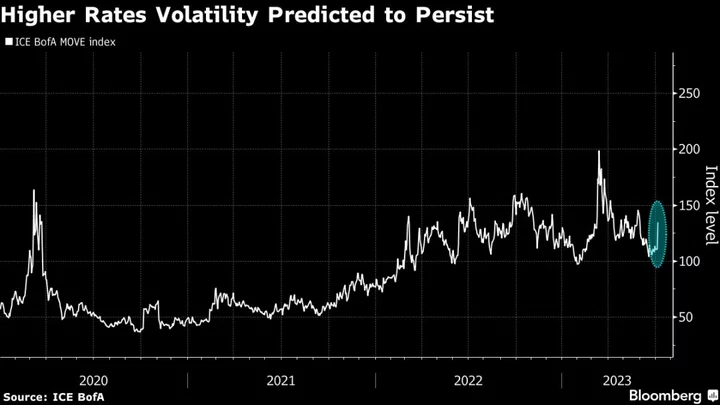The bond-market selloff that sent some yields to the highest levels in more than a decade this week leaves investors straining to see past the Federal Reserve’s next move in July.
As economic data all but extinguished doubt about a Fed interest-rate increase at the end of the month, focus shifted to the central bank’s September meeting, and investors remain deeply divided. Inflation data to be released next week could be decisive, but even if it’s benign, the need for further action at that point is likely to remain unclear.
It’s a recipe for ongoing turmoil, made worse, potentially, by the long span between the Fed’s July and September gatherings and vacation season. The ICE BofA MOVE Index, measuring expected Treasury volatility, rose the most since early March on Thursday as two- and five-year yields rocketed to the highest levels since 2007.
“Volatility is going to stay because the Fed is still in play,” said Ray Remy, co-head of fixed income at Daiwa Capital Markets America. “The economy is in good shape if you go by the jobs figures and inflation is still stubbornly high. So I don’t think we’ve seen the high for yields.”
The counterargument, advanced this week by Morgan Stanley among others, is that inflation is moderating in a way that will take pressure off the Fed after this month.
The Consumer Price Index for June, to be released July 12, is expected to show that core inflation, which excludes volatile food and energy, decelerated to a year-on-year rate of 5%, the lowest since November 2021.
Strategists at TD Securities look for an even bigger slowdown, to 4.8%, and for the signs of cooling in the US Labor Department’s June jobs report released Friday to be sustained, “making it very awkward for the Fed to hike after July,” Gennadiy Goldberg wrote. “However, the Fed will keep a fall hike alive in order to prevent the market from pricing in cuts. This is one way they’re achieving tighter financial conditions.”
As a result, he wrote, it’s risky to position for Fed rate cuts next year in response to an economic slowdown even if one expects them.
What Bloomberg’s Strategists Say
“It’s not over yet. While headline CPI in the US continues to fall from recent highs, the genie is out of the bottle, and underlying structural drivers threaten to re-elevate inflation after the current bout of disinflation peters out.”
— Simon White, macro strategist
For the full column, click here
At the end of this week, swap contracts linked to future Fed decisions were almost fully pricing in a quarter-point increase on July 26, and about 45% odds of another one by year end, down from around 50% earlier in the week.
The Fed raised its policy rate band for a 10th straight time in May, by a quarter point to 5%-5.25%. They decided on no change in June, to assess the impact that higher rates were having on the economy and banking system, but forecast two additional increases this year.
Positioning for Fed rate cuts normally entails anticipating that short-maturity Treasury yields will decline relative to longer-maturity ones — a theme that began to emerge in trading this week despite the selloff, which pushed 10- and 30-year yields to year-to-date highs Friday.
Two-year yields ended the week about 88 basis points higher than 10-year yields, down from about 111 basis points early in the week. The spread remains near the biggest in decades, a factor for those placing bets on reversion.
The long gap between the Fed’s July and September meetings has an asterisk — Fed Chairman Jerome Powell’s annual speech at the central bank’s symposium in Jackson Hole, Wyoming, in August. Fed leaders have often taken the opportunity to provide guidance about the monetary policy outlook in market-moving ways.
“There will be more rates volatility, particularly because we are also in a period of time when people usually take vacations,” said Chris Ahrens, a strategist at Stifel Nicolaus & Co.
Ironically, even volatility can’t be counted on. Strategists at Goldman Sachs Group Inc. say the Fed’s June pause makes it less likely they’ll err on the side of doing too much. Taking into account that the banking sector and market liquidity conditions have stabilized, rate volatility is “still quite elevated” and likely to ebb, Praveen Korapaty said.
What to Watch
- Economic data calendar
- July 10: Wholesale inventories; consumer credit
- July 11: NFIB Small Business Optimism
- July 12: MBA mortgage applications; Consumer Price Index; Fed Beige Book
- July 13: Producer Price Index; jobless claims; federal budget statement
- July 14: Import and export price indexes; University of Michigan sentiment
- Federal Reserve calendar
- July 10: Fed Vice Chair for Supervision Michael Barr; San Francisco Fed President Mary Daly; Cleveland Fed President Loretta Mester; Atlanta Fed President Raphael Bostic
- July 12: Richmond Fed President Tom Barkin; Minneapolis Fed President Neel Kashkari; Bostic; Mester
- July 13: Fed Governor Christopher Waller
- Auction calendar:
- July 10: 13- and 26-week bills
- July 11: 52-week bills; 42-day CMB; 3-year notes
- July 12: 17-week bills; 10-year notes
- July 13: 4- and 8-week bills, 30-year bonds
--With assistance from Edward Bolingbroke.

